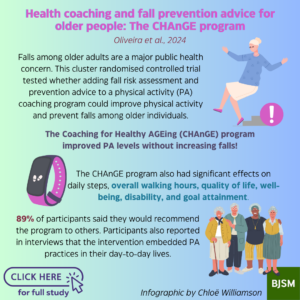Oliveira et al., 2024
In this blog, we will describe the findings of our recent trial of a coaching intervention aimed at improving physical activity and fall prevention among older people.
Why is this study important?
Falls among older adults are a huge public health issue, leading to injuries, disability, and even death. Currently, falls are estimated to cost more than $50 billion per year. This issue is growing due to the ageing of populations worldwide.
While we know that specific exercises like balance training can help to prevent many falls, it is uncertain if participation in physical activity more generally has the same beneficial effect. Conflicting information exists on whether promoting general physical activity increases risk of or prevents falls, due to the potential for greater exposure to fall hazards with greater physical activity. Therefore, iIn a large study of 605 participants, we tested whether adding fall risk assessment and prevention advice to a physical activity coaching program could improve physical activity and prevent falls among older individuals.
How did the study go about this?
We conducted a cluster randomised controlled trial with people aged 60 years and older, residing in NSW, Australia. In this trial, we included groups (or clusters) of older people. These groups were randomly assigned to intervention or control group. Participants assigned to the intervention group received the Coaching for Healthy AGEing (CHAnGE) program, which included a single home physiotherapy visit, fall risk assessment and advice on fall prevention, individualised physical activity plan and activity tracker. Subsequently, they received up to 19 telephone coaching sessions to support physical activity goals. The intervention lasted 12 months, with the dosage of telephone coaching varying – participants received bi-weekly coaching for the first 6 months and then monthly for the remaining 6 months. Participants in the control group received coaching focused on healthy eating over the entire 12-month period.
Our main goals were to see how much physical activity participants were doing (measured objectively using accelerometers)ng, measured in activity counts by a device called an accelerometer, and to track any falls using monthly calendars over 12 months. We also measured other aspects of physical activity like daily steps, time spent in moderate to vigorous activity, and hours per week spent in physical activity. Additionally, we looked at the impact of the intervention on various health-related measures such as body mass index, eating habits, goal attainment, mobility-related confidence, quality of life, fear of falling, risk-taking behaviour, mood, well-being and disability. We collected this information before participants were randomly assigned to groups and then again after 3, 6, and 12 months following randomisation to understand the impact of our program over time.
What did the study find?
We observed a significant improvement in activity counts after 6 months for participants in the CHAnGE program compared to the control group; however, this difference was not sustained at the 12-month mark. The inclusion of a fall prevention component to the physical activity intervention yielded additional benefits in reducing the rate of falls, but this reduction was not significant over a year.
The CHAnGE program did have significant benefits for six important outcomes: daily steps, overall walking hours, quality of life, well-being, disability, and goal attainment. Importantly, our trial, unlike some other physical activity studies, actually improved physical activity levels without increasing falls.
Overall, the CHAnGE program was well accepted and perceived to be beneficial, and 89% participants said they would recommend the program to others. We also interviewed CHAnGE intervention participants, and most of the interviewed participants reported that the intervention increased physical activity and embedded practices in their day-to- day lives.
While our primary goal was to evaluate the overall effectiveness of the CHAnGE intervention in a diverse sample of older people living in the community, subgroup analyses suggested a positive impact on fall prevention for those who had 2 or more falls in the past year and were less active at baseline.
What are the key take-home points for clinicians?
Our intervention holds promise in safely improvingimprove physical activity among individuals aged 60 and older without increasing the risk of falls and it may have the potential to be implemented at scale. Yet, our findings show the importance of maintaining the intervention at a moderately intense dose to sustain its impact. Additional investigation through large trials is needed to understand how the intervention impacts older people at a high risk of falls.

Authors and affiliations
Juliana S Oliveira (1,2,3), Catherine Sherrington (1,2,3) Chris Rissel (3), Kirsten Howard (3,4), Allison Tong (3), Dafna Merom (5), James Wickham (6), Adrian E Bauman (7), Stephen R Lord (8), Richard I Lindley (9), Judy M Simpson (3), Margaret Allman-Farinelli (10), Catherine Kirkham (1,2,3), Elisabeth Ramsay (1,2,3), Sandra O’Rourke (1,2,3), Anne Tiedemann (1,2,3).
1 Sydney Musculoskeletal Health, The University of Sydney, Sydney, New South Wales,
Australia
2 Institute for Musculoskeletal Health, The University of Sydney and Sydney Local
Health District, Sydney, New South Wales, Australia
3 Sydney School of Public Health, The University of Sydney, Sydney, New South Wales,
Australia
4 Menzies Centre for Health Policy and Economics, Sydney School of Public Health,
The University of Sydney, Sydney, New South Wales, Australia
5 School of Health Sciences, Western Sydney University, Sydney, New South Wales,
Australia
6 School of Dentistry and Medical Sciences, Charles Sturt University, Orange, New
South Wales, Australia
7 Prevention Research Collaboration, Sydney School of Public Health, The University of
Sydney, Sydney, New South Wales, Australia
8 Neuroscience Research Australia, Randwick, New South Wales, Australia
9 Sydney Medical School, Discipline of Medicine, The University of Sydney, Sydney,
New South Wales, Australia
10 Nutrition and Dietetics, School of Nursing, Faculty of Medicine